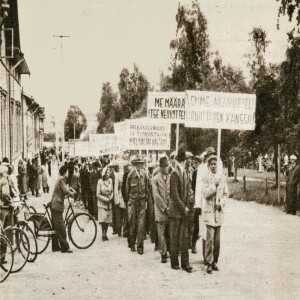

On this day in Labor History the year was 1949.
That was the day that is remembered as “Kemi Bloody Thursday” in Finland.
Two strikers were killed.
Kemi is a lumber town in northern Finland.
The lumber workers in the area went out on strike when the government proposed slashing their wages by more than thirty percent.
The strike was soon joined by sawmill and dock workers.
The walk out caused a massive log-jam on the Kemijoki River.
On the fateful day 3,000 strikers engaged in a peaceful march.
They encountered armed police, and a confrontation ensued.
The police had guns on their side.
The workers had only rocks and sticks.
One striker was shot and killed.
Another was hit by a truck.
Finnish army troops were called in to Kemi.
Twenty-two strike leaders were arrested.
In response to the violence, sympathy strikes were called by other unions, including the seaman’s union.
These strikes were seen by many as a fight between the Finnish elected government and Communists in the nation’s trade unions.
Officials in the United States worried the strikes were an attempt by Communists to open the door to intervention in Finland by the Soviet Union.
After World War II, Cold War politics shaped responses to labor struggles in many nations.
A song, Fly Black-Winged Bird, remembers the fallen workers.
The lyrics, translated to English, begin, “Fly, black-winged bird, with blood on your feathers across the lands. From village to village carry your message. Open up, Autumn sky for the sad news to spread. Shame on a country where an unarmed man gets shot. Shame on the one who calls the shots.”
More Episodes
All Episodes>>You may also like
Create Your Podcast In Minutes
- Full-featured podcast site
- Unlimited storage and bandwidth
- Comprehensive podcast stats
- Distribute to Apple Podcasts, Spotify, and more
- Make money with your podcast











